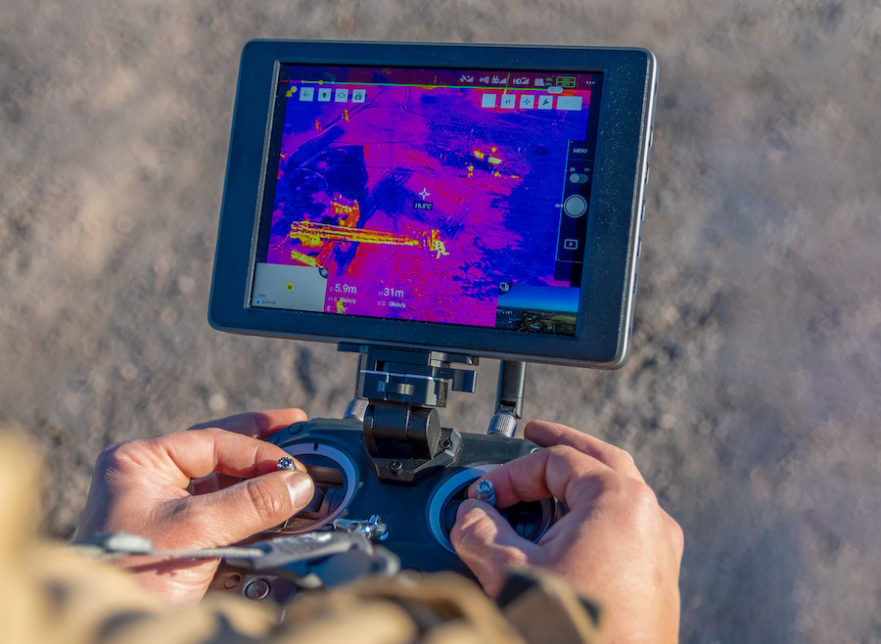While ground-penetrating radar (GPR) is one of the most versatile imaging techniques, it is not without certain challenges. GPR is designed to give a picture of an object’s outline as it resides underground.
It is unable to differentiate between, for example, a utility line and a small sinkhole. The operator is left to determine what objects are located beneath the ground based on their shape and other external pieces of information.
This can make differentiating certain subterranean features difficult. Sewer lines and underground electrical lines may look similar despite being different.
Infrared thermography is often paired with GPR to overcome these limitations. Let’s take a look at what infrared thermography is and why it provides unique information about underground features.
What is Infrared Thermography?
Infrared thermography is a special imaging technique that works like a super camera. It doesn’t just show the shape of things, but also their temperature. This is really cool because it can tell us a lot about things hidden underground. For example, it can show us that electrical lines are hotter than the ground around them because they have electricity running through them. On the other hand, sewer lines are cooler and bigger.
This super camera is not just for looking at things underground. It’s also very useful in building work. It can help us understand how thick different parts of a building are. It can also check heating and cooling systems. One of its best uses is finding water in walls. Water can damage buildings over time, so finding it early is very important.
Another great thing this camera can do is find “thermal bridges“. These are parts of a building that let heat escape more than others. By finding these, we can make buildings more energy-efficient. This means they use less energy, which is good for our planet.
In short, infrared thermography is a powerful tool that gives us a kind of superpower. It can show us things we can’t see with our eyes and help us understand our world better. So, when we ask “what is infrared thermography?”, the answer is: it’s a super camera that helps us see and understand our world in amazing new ways!
For more detailed information and case studies, check out these sources: [Infrared Thermography in Building Assessment], [Ground Penetrating Radar and Infrared Thermography for Bridge Deck Condition Evaluation], [Summary of IRT and GPR techniques].
Why Use Infrared Thermography Over GPR?
While GPR does an amazing job in locating the shapes of underground features, the information it can acquire is limited. Infrared thermography adds more definition to those shapes without requiring any dirt to be moved.
With these added details comes a certain clarity that enhances the information about the ground beneath a property. Utility lines that may be unmarked, such as underground electrical lines running as a subcircuit, can be identified without posing danger to others or requiring unneeded repairs.
The other major advantage of infrared thermography is the fact that it can be used to differentiate between different geological features. A sink hole, for example, can appear similar to a deposit of lose-density sediment. Moisture will typically make the sinkhole warmer than the surroundings, which in turn can help to identify a potential danger from a mere geological feature.
Applications of Infrared Thermography and GPR
Structural Safety: Infrared thermography and Ground-Penetrating Radar (GPR) are used to ensure the safety of building structures. They can detect anomalies that could compromise the structural integrity of a building, such as hidden cracks or defects in the materials. This is crucial in preventing potential building collapses and ensuring the safety of the occupants.
Energy Efficiency and Well-Being: These technologies are also used to improve energy efficiency and the well-being of building occupants. They can identify areas where heat is escaping, known as thermal bridges, which can lead to increased energy consumption. By identifying these areas, measures can be taken to improve insulation and reduce energy use, leading to a more comfortable living environment and lower energy bills.
Heritage Preservation: Infrared thermography and GPR are invaluable tools in the preservation of historic buildings. They can detect moisture, which can lead to structural damage over time, and help identify the best ways to preserve and restore these important structures without causing further damage.
Detection of Hidden Targets or Structural Elements: These technologies can reveal hidden features within a building, such as embedded rebars in concrete or hidden wall cavities. This can be useful in renovation projects or when planning structural modifications.
Inspection of Basement: Basements can be challenging to inspect due to their underground location. Infrared thermography and GPR can detect issues such as water leaks or structural weaknesses, helping to prevent costly repairs down the line.
Detection of Moisture: Moisture can cause significant damage to buildings over time. These technologies can detect moisture within walls or other building materials, allowing for early intervention and prevention of further damage.
For more detailed information on the applications of Infrared Thermography and GPR.
Underground Information is Your Ally
Information about what is underground is your ally in any activity dealing with construction. It can prevent costly repairs on utility lines, make any work safer for individuals to perform, and help to ensure that complications can be planned and minimized before a project begins.
To learn more about our services, contact us by using the form on our contact page or give us a call at (972) 724-5550.

